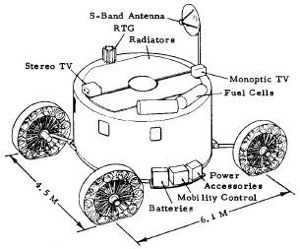
Home - Search - Browse - Alphabetic Index: 0- 1- 2- 3- 4- 5- 6- 7- 8- 9
A- B- C- D- E- F- G- H- I- J- K- L- M- N- O- P- Q- R- S- T- U- V- W- X- Y- Z
MOCAN
 MOCAN |
Status: Study 1966. Gross mass: 4,077 kg (8,988 lb).
The CAN was mounted on a rectangular aluminum box beam frame and supported by four 203-cm-diameter metal-elastic wheels. The CAN was designed to utilize fully the volume on top of the LM Truck and within the Spacecraft LM Adaptor (SLA). The MOCAN mission was reduced to an 8-day duration and a 200-km range in an effort to bring the vehicle mass down to the LM Truck payload capacity. The weight savings effected by this reduction in mission performance were mobility (34.1 kg), power (200 kg), and life support expendables (57.7 kg), for a total mass savings of 291.8 kg. This reduced the MOCAN delivered mass from 4077 kg to 3785 kg, which was within the 3860-kg LM Truck payload capacity. The MOCAN, with a free volume almost five times greater than required, offered a large growth potential with respect to extensions in mission duration or increases in crew size. However, in order for the MOCAN delivered mass to meet the assumed LM Truck payload, the range requirement had to be reduced to 200 km and the mission duration reduced to 8 days. None of the three mobility derivative vehicles (MOLEM, MOCOM, and MOCAN) were retained as MOBEV Design Point Vehicles. They did not offer the planner any measurable advantages in terms of performance, mass, or cost over a system which was designed specifically for mobility use, such as MOLAB.
MOCAN Summary
- Delivered Mass (kg): 4077 (3785 for degraded version deliverable by baseline LM Truck)
- Cabin Free Volume (ft3): 810
- Total Mission Energy (kwh): 734 (435 for degraded version)
- Mobility Specific Energy (kwh/km): .59 (.52 for degraded version)
- Maximum Average Speed-ELMS (km/hr): 10.
- Obstacle Negotiability: (cm) 60 (70 for degraded version)
- Crevice Negotiability: (cm} 146 (157 for degraded version)
- Development Cost: ($million) 291.7
- Development Time (years): 4.75
- Storage Envelope and Mass: LM Truck, 3860 kg
- Crew Size: Two, 95th Percentile
- Scientific Mission Duration: 14 Days (+7 Day Life Support Contingency)
- Lunar Standby Period: Six Months
- Operating Period: One lunar Day and/or Night
- Scientific Payload & Energy: 320 kg and 73 kWH
- Mobility Range & Radius: 400 km and 80 km
- Surface Model: ELMS: 50/50 Maria and Highland
- Ingress/Egress Cycles: 40
- Vehicle Operation: Manned and Remote Control
Comparison of significant characteristics for MOLEM, MOCOM, and MOCAN showed that each of the designs provided for a crew of two and a scientific payload of 320 kg for a 14-day mission with a 400-km range. The only vehicle exceeding the LM Truck payload capability of 3860 kg for a full-up mission was the MOCAN. Since the delivery mass constraint had been exceeded, MOCAN performance had to be degraded to a 200-km, 8-day mission in order to meet the assumed LM Truck payload. The cabin free volumes, with the exception of MOLEM, were within the NASA stipulated desired volume of 175 cu ft for a two-man, 14-day mission. Fuel cell systems were used for primary power and were sized to supply the total energy requirements of 693, 695, and 734 kwh, respectively, for the MOLEM, MOCOM, and MOCAN. Mobility specific energy for MOLEM, MOCOM, and MOCAN were, respectively, 0.44, 0.49, and 0.59 kwh/km. The maximum average speed was 10 km/hr, over a 50/50 ELMS and 16.7 km/hr on a hard surface for all three vehicles. Obstacle and crevice negotiability was based on vehicle geometry. For MOLEM, MOCOM, and MOCAN, respectively, the obstacle negotiability was 80, 70, and 60 cm; and the crevice negotiability was 173, 157, and 146 cm. Development costs of $273.3 million for MOLEM, $282.3 million for MOCOM, and $291.7 million for MOCAN do not include the cost of 13 basic development shells or the flight shell. Development time for all three mobility derivatives was 4.75 years.
Crew Size: 2.
Family: Lunar Rovers, Moon. Country: USA. Agency: NASA, Boeing. Bibliography: 1994.
Back to top of page
Home - Search - Browse - Alphabetic Index: 0- 1- 2- 3- 4- 5- 6- 7- 8- 9
A- B- C- D- E- F- G- H- I- J- K- L- M- N- O- P- Q- R- S- T- U- V- W- X- Y- Z
© 1997-2019 Mark Wade - Contact
© / Conditions for Use